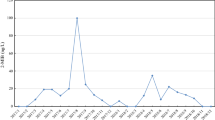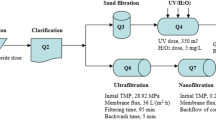Abstract
Sudden odor incidents occurring in the source water have been a severe problem for water suppliers. In order to apply emergency control measures effectively, it is necessary to identify the target compounds responsible for odor incidents rapidly. The present work identified the odorants and explored emergency disposal mechanisms for sudden and severe odors in the QT River’s drinking water source (HZ city, China). Medicinal, chemical, septic, and musty odors with strong intensities were detected in the source water. The effect of conventional treatments of drinking water treatment plant (DWTP) on odors’ removal was limited, which was evident by the presence of medicinal, chemical, and musty odors with moderate intensities in the effluent of DWTP. Total seventeen odorants were identified successfully in the source water of QT River and the effluent of DWTP. The measured OAVs and reconstituting the identified odorants explained 87, 87, 89, and 94% of medicinal, chemical, septic, and musty odors, respectively, in the source water of the QT River and 90, 87, and 88% of medicinal, chemical, and musty odors in the effluent. Styrene, phenol, 2-chlorophenol, 2-tert-butylphenol, and 2-methylphenol were associated with the medicinal odor, while propyl sulfide, diethyl disulfide, propyl disulfide, and indole were related to the septic odor. Geosmin and 2-methylisoborneol (2-MIB) were responsible for the musty odor, and cyclohexanone, 1,4-dichlorobenzene, and nitrobenzene were involved with the chemical odor. Based on the characteristics of identified odorants, powdered activated carbon (PAC) was applied to control the odors in the QT River. The results indicated that the medicinal, chemical, septic, and musty odors could be removed entirely after adding 15 mg/L PAC, which effectively controlled emergency odor problems. Overall, the study would offer a scientific basis and operational reference for emergency odor management and control in DWTP with similar complicated odor incidents.






Similar content being viewed by others
Data availability
All data generated or analyzed during this study are included in this published article (and its supplementary information files).
References
Adahchour M, Beens J, Brinkman UAT (2008) Recent developments in the application of comprehensive two-dimensional gas chromatography. J Chromatogr A 1186(1-2):67–108
Agus E, Zhang LF, Sedlak DL (2012) A framework for identifying characteristic odor compounds in municipal wastewater effluent. Water Res 46(18):5970–5980
Antonopoulou M, Evgenidou E, Lambropoulou D, Konstantinou I (2014) A review on advanced oxidation processes for the removal of taste and odor compounds from aqueous media. Water Res 53:215–234
APHA (2005) Standard methods for the examination of water and wastewater. APHA American Public Health Association
ASTM (1997) Standard Practice Designation E 679-91. Am Soc Test Mat:34–38
Benkwitz F, Nicolau L, Lund C, Beresford M, Wohlers M, Kilmartin PA (2012) Evaluation of key odorants in sauvignon blanc wines using three different methodologies. J Agric Food Chem 60(25):6293–6302
Botalova O, Schwarzbauer J, Frauenrath T, Dsikowitzky L (2009) Identification and chemical characterization of specific organic constituents of petrochemical effluents. Water Res 43(15):3797–3812
Chen F, Tang F, Xu J, Wang Y, Ruan D, Zhang W, Zhou S (2018) Pollution characteristics and health risk assessment of volatile organic compounds (VOCs) and semi-volatile organic compounds (SVOCs) in QT river’s HZ section during a water odor pollution event. Environ Sci 39(2):648–654
Chin S-T, Eyres GT, Marriott PJ (2011) Identification of potent odourants in wine and brewed coffee using gas chromatography-olfactometry and comprehensive two-dimensional gas chromatography. J Chromatogr A 1218(42):7487–7498
Davi ML, Gnudi F (1999) Phenolic compounds in surface water. Water Res 33(14):3213–3219
Dietrich AM, Phetxumphou K, Gallagher DL (2014) Systematic tracking, visualizing, and interpreting of consumer feedback for drinking water quality. Water Res 66:63–74
Dietrich AM, Thomas A, Zhao Y, Smiley E, Shanaiah N, Ahart M, Charbonnet KA, DeYonker NJ, Alexander WA, Gallagher DL (2015) Partitioning, aqueous solubility, and dipole moment data for cis- and trans-(4-Methylcyclohexyl)methanol, principal contaminants of the West Virginia chemical spill. Environ Sci Technol Letters 2(4):123–127
Gallagher DL, Phetxumphou K, Smiley E, Dietrich AM (2015) Tale of two isomers: complexities of human odor perception for cis-and trans-4-Methylcyclohexane methanol from the chemical spill in West Virginia. Environ Sci Technol 49(3):1319–1327
Guo Q (2016) Identification and control of septic odor causing compounds in a river-type source water of south China. Doctoral Thesis.
Guo Q, Li X, Yu J, Zhang H, Zhang Y, Yang M, Lu N, Zhang D (2015) Comprehensive two-dimensional gas chromatography with time-of-flight mass spectrometry for the screening of potent swampy/septic odor-causing compounds in two drinking water sources in China. Anal Methods 7(6):2458–2468
Guo Q, Yang K, Yu J, Wang C, Wen X, Zhang L, Yang M, Xia P, Zhang D (2016a) Simultaneous removal of multiple odorants from source water suffering from septic and musty odors: Verification in a full-scale water treatment plant with ozonation. Water Res 100:1–6
Guo Q, Yu J, Yang K, Wen X, Zhang H, Yu Z, Li H, Zhang D, Yang M (2016b) Identification of complex septic odorants in Huangpu River source water by combining the data from gas chromatography-olfactometry and comprehensive two-dimensional gas chromatography using retention indices. Sci Total Environ 556:36–44
Guo Q, Yu J, Su M, Wang C, Yang M, Cao N, Zhao Y, Xia P (2019a) Synergistic effect of musty odorants on septic odor: Verification in Huangpu River source water. Sci Total Environ 653:1186–1191
Guo Q, Yu J, Zhao Y, Liu T, Su M, Jia Z, Zhao Y, Mu Z, Yang M (2019b) Identification of fishy odor causing compounds produced by Ochromonas sp. and Cryptomonas ovate with gas chromatography-olfactometry and comprehensive two-dimensional gas chromatography. Sci Total Environ 671:149–156
Guo Q, Yu J, Li X, Chen T, Wang C, Li Z, Ma W, Ding C, Yang M (2020) A systematic study on the odorants characterization and evaluation in a plain reservoir with wetlands ecosystem. J Hazard Mater 393
He Q, Zhong L, Wang H, Zou Z, Chen D, Yang K (2016) Odor removal by powdered activated carbon (PAC) in low turbidity drinking water. Water Sci Technol Water Sci Technol 16(4):1017–1023
Hu J, Dong H, Xu Q, Ling W, Qu J, Qiang Z (2018) Impacts of water quality on the corrosion of cast iron pipes for water distribution and proposed source water switch strategy. Water Res 129:428–435
Hu RY, Liu GJ, Zhang H, Xue HQ, Wang X, Lam PKS (2020) Odor pollution due to industrial emission of volatile organic compounds: A case study in Hefei, China. J Clean Prod 246:1–11
Huang X, Lu Q, Hao H, Wei Q, Shi B, Yu J, Wang C, Wang Y (2019) Evaluation of the treatability of various odor compounds by powdered activated carbon. Water Res 156:414–424
Huang X, Shi B, Hao H, Su Y, Wu B, Jia Z, Wang C, Wang Q, Yang M, Yu J (2020) Identifying the function of activated carbon surface chemical properties in the removability of two common odor compounds. Water Res:178
Kalweit C, Stottmeister E, Rapp T (2019) Contaminants migrating from crossed-linked polyethylene pipes and their effect on drinking water odour. Water Res 161:341–353
Li L, Gao NY, Deng Y, Yao J, Zhang K (2012a) Characterization of intracellular & extracellular algae organic matters (AOM) of Microcystic aeruginosa and formation of AOM-associated disinfection byproducts and odor & taste compounds. Water Res 46(4):1233–1240
Li Z, Hobson P, An W, Burch MD, House J, Yang M (2012b) Earthy odor compounds production and loss in three cyanobacterial cultures. Water Res 46(16):5165–5173
Li X, Wang J, Zhang X, Chen C (2015) Powdered activated carbon adsorption of two fishy odorants in water: Trans, trans-2,4-heptadienal and trans, trans-2,4-decadienal. J Environ Sci 32:15–25
Li L, Zhu C, Xie C, Shao C, Yu S, Zhao L, Gao N (2018) Kinetics and mechanism of Pseudoanabaena cell inactivation, 2-MIB release and degradation under exposure of ozone, chlorine and permanganate. Water Res 147:422–428
Li L, Yang S, Yu S, Zhang Y (2019) Variation and removal of 2-MIB in full-scale treatment plants with source water from Lake Tai, China. Water Res 162:180–189
Li L, Li J, Zhu C, Yu S (2020) Study of the binding regularity and corresponding mechanism of drinking water odorous compound 2-MIB with coexisting dissolved organic matter. Chem Eng J 395:125015
Lin TF, Wong JY, Kao HP (2002) Correlation of musty odor and 2-MIB in two drinking water treatment plants in South Taiwan. Sci Total Environ 289(1-3):225–235
Liu H, Luo G-Q, Hu H-Y, Zhang Q, Yang J-K, Yao H (2012) Emission characteristics of nitrogen- and sulfur-containing odorous compounds during different sewage sludge chemical conditioning processes. J Hazard Mater 235:298–306
Liu ZH, Yin H, Dang Z (2017) Do estrogenic compounds in drinking water migrating from plastic pipe distribution system pose adverse effects to human? An analysis of scientific literature. Environ Sci Pollut R 24(2):2126–2134
Liu J, Lu C, Huang L, Sun J, Yue P, Liu X, Kang X (2021) Performance and economic analyses of a combined bioreactor for treating odors, volatile organic compounds, and aerosols from a landfill site. J Clean Prod 278
Lu X, Fan C, He W, Deng J, Yin H (2013) Sulfur-containing amino acid methionine as the precursor of volatile organic sulfur compounds in algea-induced black bloom. J Environ Sci 25(1):33–43
Ma X, Hu S, Wang H, Li J, Huang J, Zhang Y, Lu W, Li Q (2012) Kinetics of oxidation of dimethyl trisulfide by potassium permanganate in drinking water. Front Environ Sci Eng 6(2):171–176
Ma C, Shi WX, Wang L, Zhao X, Zhao B, Guo XF, Zhang ZH, Zhang HW (2016) Effect of disinfection method on odor and disinfection byproduct control in drinking water treatment. Desalination Water Trea 57(17):7753–7762
Matsui Y, Nakano Y, Hiroshi H, Ando N, Matsushita T, Ohno K (2010) Geosmin and 2-methylisoborneol adsorption on super-powdered activated carbon in the presence of natural organic matter. Water Sci Technol 62(11):2664–2668
Mayuoni-kirshinbaum L, Tietel Z, Porat R, Ulrich D (2012) Identification of aroma-active compounds in 'wonderful' pomegranate fruit using solvent-assisted flavour evaporation and headspace solid-phase micro-extraction methods. Eur Food Res Technol 235(2):277–283
Omoike AI, Harmon D (2019) Slow-releasing permanganate ions from permanganate core-manganese oxide shell particles for the oxidative degradation of an algae odorant in water. Chemosphere 223:391–398
Quintana J, Vegué L, Martín-Alonso J, Paraira M, Boleda MR, Ventura F (2016) Odor Events in Surface and Treated Water: The Case of 1,3-Dioxane Related Compounds. Environ Sci Technol 50(1):62–69
Sain AE, Dietrich AM, Smiley E, Gallagher DL (2015) Assessing human exposure and odor detection during showering with crude 4-(methylcyclohexyl)methanol (MCHM) contaminated drinking water. Sci Total Environ 538:298–305
Schiffman SS, Bennett JL, Raymer JH (2001) Quantification of odors and odorants from swine operations in North Carolina. Agric For Meteorol 108(3):213–240
Sheng X, Wang Q, Chen L, Shen Z, Pei Y (2016) Determination and Correlation for the Solubility of Glutaric Acid in Cyclohexane plus Cyclohexanol plus Cyclohexanone Solvent Mixtures. J Chem Eng Data 61(11):3761–3769
Suffet IH, Khiari D, Bruchet A (1999) The drinking water taste and odor wheel for the millennium: Beyond geosmin and 2-methylisoborneol. Water Sci Technol 40(6):1–13
Suffet IH, Schweitze L, Khiari D (2004) Olfactory and chemical analysis of taste and odor episodes in drinking water supplies. Rev Environ Sci Biotechnol 3(1):3–13
Sun D, Yu J, An W, Yang M, Chen G, Zhang S (2013) Identification of causative compounds and microorganisms for musty odor occurrence in the Huangpu River, China. J Environ Sci 25(3):460–465
Wang C, Yu J, Guo Q, Zhao Y, Cao N, Yu Z, Yang M (2019a) Simultaneous quantification of fifty-one odor-causing compounds in drinking water using gas chromatography-triple quadrupole tandem mass spectrometry. J Environ Sci 79:100–110
Wang C, Yu J, Guo Q, Sun D, Su M, An W, Zhang Y, Yang M (2019b) Occurrence of swampy/septic odor and possible odorants in source and finished drinking water of major cities across China. Environ Pollut 249:305–310
Watson SB (2004) Aquatic taste and odor: a primary signal of drinking - water integrity. J Toxicol Env Heal A 67(20-22):1779–1795
Yang M, Yu J, Li Z, Guo Z, Burch M, Lin T-F (2008) Taihu Lake Not to Blame for Wuxi's Woes. Science 319(5860):158–158
Young WF, Horth H, Crane R, Ogden T, Arnott M (1996) Taste and odour threshold concentrations of potential potable water contaminants. Water Res 30(2):331–340
Yu JW, Zhao YM, Yang M, Lin T-F, Guo ZH, Gu JN, Li S, Han W (2009) Occurrence of odour-causing compounds in different source waters of China. J Water Supply Res Technol 58(8):587–594
Zhang K, Lin TF, Zhang T, Li C, Gao N (2013) Characterization of typical taste and odor compounds formed by Microcystis aeruginosa. J Environ Sci 25(8):1539–1548
Acknowledgements
This study was supported by Funds for the National Natural Science Foundation of China (No. 21707117, 51878587), China Postdoctoral Science Foundation Grant (2018 M631602), Jiangsu Natural Science Foundation of China (No. BK20160438).
Author information
Authors and Affiliations
Contributions
Qingyuan Guo: Conceptualization, Software, Writing - Original Draft. Zhaoxia Li: Validation, Visualization, Formal analysis. Tianming Chen: Data curation, Methodology. Bairen Yang: Investigation, Project administration. Cheng Ding: Conceptualization, Supervision. All authors read and approved the final manuscript.
Corresponding authors
Ethics declarations
Conflict of interest
The authors declare that they have no conflicts of interest.
Ethical approval
Not applicable.
Consent to participate
Not applicable.
Consent to publish
Yes.
Additional information
Responsible Editor: Philippe Garrigues
Publisher’s note
Springer Nature remains neutral with regard to jurisdictional claims in published maps and institutional affiliations.
Supplementary Information
ESM 1
(DOC 1827 kb)
Rights and permissions
About this article
Cite this article
Guo, Q., Li, Z., Chen, T. et al. Implications for emergency response to the severe odor incident occurred in source water: Potential odorants and control strategy. Environ Sci Pollut Res 28, 67022–67031 (2021). https://doi.org/10.1007/s11356-021-15218-1
Received:
Accepted:
Published:
Issue Date:
DOI: https://doi.org/10.1007/s11356-021-15218-1




